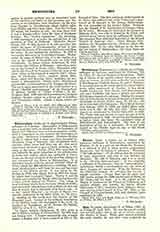

Rhinocolura, titular see in Augustamnica Prima, suffragan of Pelusium. Rhinocolura or Rhinocorura was a maritime town so situated on the boundary of Egypt and Palestine that ancient geographers attributed it sometimes to one country and sometimes to the other. Its history is unknown. Diodorus Siculus (I, 60, 5) relates that it must have been founded by Actisanes, King of Ethiopia, who established there convicts whose noses had been cut off; this novel legend was invented to give a Greek meaning to the name of the town. Strabo (XVI, 781) says that it was formerly the great emporium of the merchandise of India and Arabia, which was unloaded at Leuce Come, on the eastern shore of the Red Sea, whence it was transported via Petra to Rhinocolura. It is identified usually with the present fortified village El Arish, which has 400 inhabitants, excluding the garrison, situated half a mile from the sea, and has some ruins of the Roman period. It was taken by the French in 1799, who signed there in 1800 the treaty by which they evacuated Egypt. Today it and its vicinity are occupied by Egypt, after having been for a long period claimed by Turkey. The village is near a stream which bears its name (Wadi el-Arish), and receives its waters from central Sinai; it does not flow in winter, but is torrential after heavy rain. It is the “nahal Misraim”, or stream of Egypt, frequently mentioned in the Bible (Gen., xv, 18, etc.), as marking on the southwest the frontier of the Promised Land. Instead of the ordinary translation of the Hebrew name; the Septuagint in Is., xxvii, 12, render it by GK ‘Plvou6povpa; see St. Jerome (In Isaiam, XXVII, 12 in P.L., XXIV, 313).
Le Quien (Oriens Christianus, II, 541) gives a list of thirteen bishops of Rhinocolura: the first does not belong to it. A Coptic manuscript also wrongly names a bishop said to have assisted in 325 at the Council of Nice. The first authentic titular known is St. Melas, who suffered exile under Valens and is mentioned on January 16 in the Roman Martyrology. He was succeeded by his brother Solon. Polybius was the disciple of St. Epiphanius of Cyprus, whose life he wrote. Hermogenes assisted at the Council of Ephesus (431), was sent to Rome by St. Cyril, and received many letters from his suffragan St. Isidore. His successor Zeno defended Eutyches at the Second Council of Ephesus (451). Other bishops were: Alphius, the Massalian heretic; Ptolemy, about 460, Gregory, 610. Of the other bishops on the list one did not belong to Rhinocolura; the other three are Coptic heretics.
S. PETRIDES

